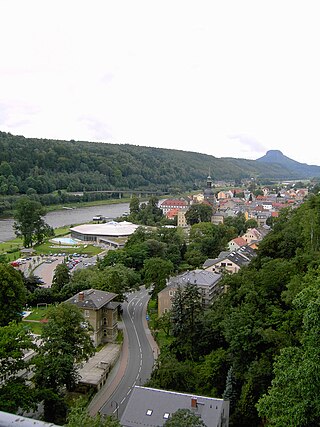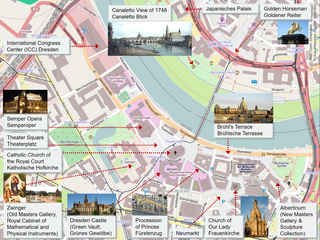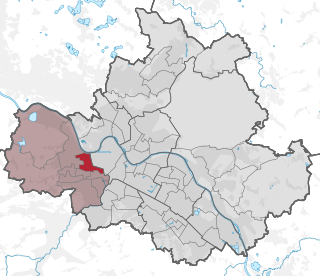
Dresden is the capital city of the German state of Saxony and its second most populous city after Leipzig. It is the 12th most populous city of Germany, the fourth largest by area, and the third most populous city in the area of former East Germany, after Berlin and Leipzig. Dresden's urban area comprises the towns of Freital, Pirna, Radebeul, Meissen, Coswig, Radeberg and Heidenau and has around 790,000 inhabitants. The Dresden metropolitan area has approximately 1.34 million inhabitants.

The Elbe is one of the major rivers of Western Europe. It rises in the Giant Mountains of the northern Czech Republic before traversing much of Bohemia, then Germany and flowing into the North Sea at Cuxhaven, 110 kilometres northwest of Hamburg. Its total length is 1,094 km (680 mi).

Loschwitz Bridge is a cantilever truss bridge over the river Elbe in Dresden the capital of Saxony in Germany. It connects the city districts of Blasewitz and Loschwitz, two affluent residential areas, which around 1900 were amongst the most expensive in Europe. It is located close to Standseilbahn Dresden funicular railway and the world's oldest suspension railway Schwebebahn Dresden, as well as near the Dresden TV tower. The bridge is colloquially referred to as Blaues Wunder. This common name purportedly referred to the bridge's original blue colour and being seen as a technological miracle at the time; it is also understood to carry the cynical connotation referencing the German idiom ein blaues Wunder erleben meaning "to experience an unpleasant surprise", reflecting the skeptical view of contemporary commentators. There is also a bridge in Wolgast known as Blaues Wunder.

Bad Schandau is a spa town in Germany, in the Sächsische Schweiz-Osterzgebirge district of Saxony. It is situated on the right bank of the Elbe, at the mouth of the valley of the Kirnitzsch and in the area often described as Saxon Switzerland.

Loschwitz is a borough (Stadtbezirk) of Dresden, Germany, incorporated in 1921. It consists of ten quarters (Stadtteile):

The Elbhangfest is a street festival held in Dresden, Germany on the last weekend of June each year since 1990, focusing on the unique culture and built landscape of the hillsides on the banks of the Elbe river.

The Dresden Elbe Valley is a cultural landscape and former World Heritage Site stretching along the Elbe river in Dresden, the state capital of Saxony, Germany. The valley, extending for some 20 kilometres (12 mi) and passing through the Dresden Basin, is one of two major cultural landscapes built up over the centuries along the Central European river Elbe, along with the Dessau-Wörlitz Garden Realm downstream.

Wilhelmsburg is a quarter (Stadtteil) of Hamburg, Germany within the borough (Bezirk) of Hamburg-Mitte. It is situated on several islands between the Northern and Southern branches of the Elbe river, together with the other quarters of Steinwerder, Veddel and Kleiner Grasbrook. The latter almost exclusively consists of facilities of the port of Hamburg. In 2020 the population was 53,064.

Dresden is a cultural centre in Germany which has influenced the development of European culture. "It is [...] outstanding as a cultural landscape, an ensemble that integrates the celebrated Baroque setting and suburban garden city into an artistic whole within the river valley, and as an example of land use, representing an exceptional development of a major Central-European city."
Dresden is a large city in the eastern Saxony nearby the border to the Czech Republic at the river Elbe. The geography and urban development of Dresden is embossed by the valley location and by the Elbe stream.

The Holy Cross Church is a Catholic church in the Bornheim district of Frankfurt am Main (Germany). It is similar in design to the Frauenfriedenskirche in Frankfurt-Bockenheim. It was built by Martin Weber from 1928 to 1929, on a rise then known as Bornheimer Hang. The church is an unusual example of interwar modernism as sacred Bauhaus architecture.

Dresdner Verkehrsbetriebe AG (DVB) is the municipal transport company of the city of Dresden in Germany. It is a member of the Verkehrsverbund Oberelbe transport association that manages a common public transport structure for Dresden and its surrounding areas. The DVB operates the Dresden tram network comprising 12 tram lines, with a total line length of approximately 210 kilometres (130.5 mi) and a total route length of 132.7 kilometres (82.5 mi), and 28 bus lines, with a total line length of approximately 306 kilometres (190.1 mi). It is also responsible for two funicular railways and three ferries across the River Elbe.

Schilling & Graebner was an architecture firm based in Dresden, Germany, founded by the architects Rudolf Schilling (1859–1933) and Julius Graebner (1858–1917) in 1889. The firm was under their direction from 1889 until Graebner's death, but continued to exist until 1947, most notably under Graebner's son Erwin (1895–1945). The firm, which initially devoted itself primarily to historicism and later to Art Nouveau and early modernism, worked on mainly buildings in Saxony, including several noteworthy churches, Dresden villas, administrative buildings and entire residential districts. One of the firms' most important works is the Christuskirche in Dresden (1903–1905), which arguably marks the transition of sacral architecture in Germany from historicism to modernity.

Albrechtsberg Palace or Albrechtsberg Castle is a Neoclassical stately home above the Elbe river in the Loschwitz district of Dresden. It was erected in 1854 according to plans designed by the Prussian court and landscaping architect Adolf Lohse (1807–1867) at the behest of Prince Albert, younger brother of the Prussian king Frederick William IV.

James Buchanan Aurig was a German photographer. He photographed the royal family of King Frederick Augustus III of Saxony. The photography series was published by C. A. Maschke onto postcards.

Klotzsche is a borough (Stadtbezirk) of Dresden, Germany. It consists of four quarters (Stadtteile):

Bühlau is a quarter in the east of the Saxon capital Dresden and belongs to the statistical quarter Bühlau/Weißer Hirsch. It lies in the outside of the Elbe valley between the Dresden Heath and the Schoenfeld Upland. It was first mentioned in 1349, in 1839 it formed a country commune together with Quohren and in 1921 it became incorporated into Dresden. Today, Buehlau is part of one of the Dresden villa quarters.

The following outline is provided as an overview of and topical guide to Dresden:

The Keppgrund is a wooded side valley of the River Elbe between Loschwitz and Pillnitz, near Dresden in Saxony, Germany. It is part of the conservation area Elbhänge Dresden – Pirna. The Keppbach, a brook rising in the Schönfeld Upland and about 5 kilometres (3.1 mi) long, flows through the valley into the Elbe.

Cotta, located in the western part of the Saxony state capital Dresden, is a district within the city of the same name.























